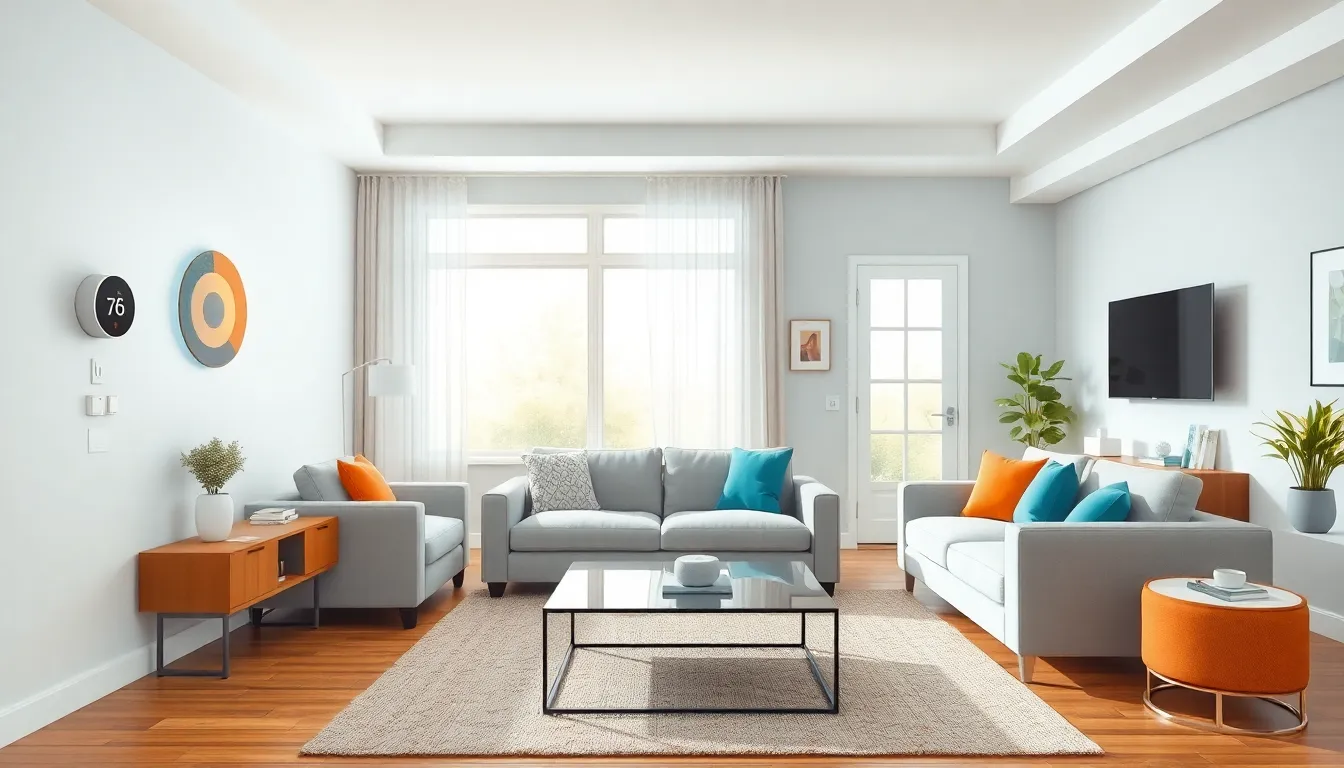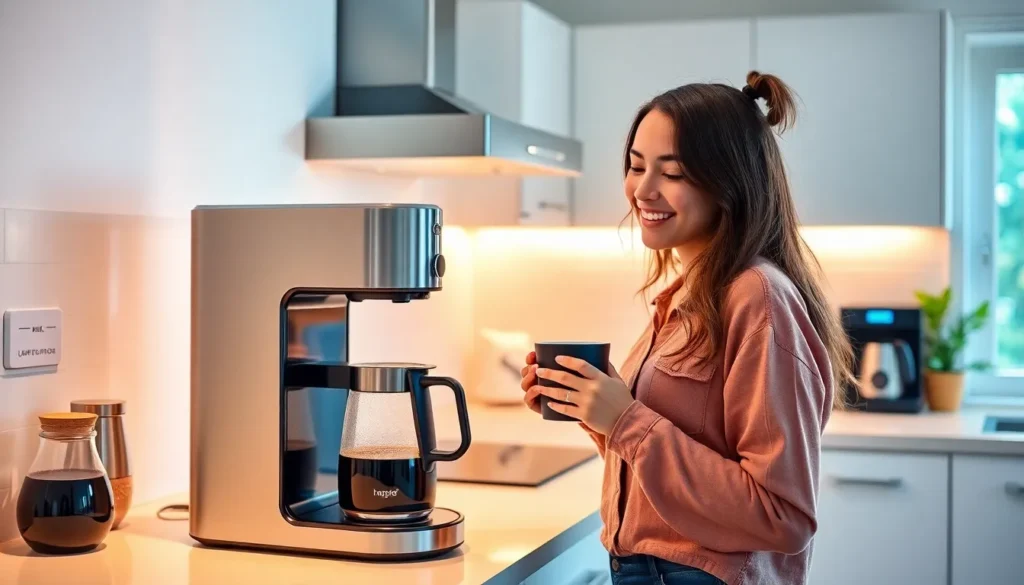Imagine walking into your home and having it greet you like a loyal pet, adjusting the lights and temperature to your liking without you lifting a finger. Welcome to the world of smart homes powered by the Internet of Things (IoT), where everyday appliances become your personal assistants. Gone are the days of fumbling with remote controls and forgetting to turn off the lights; now, your home can think for itself—sort of like a teenager, but way more reliable.
As smart devices become increasingly integrated into daily life, they promise not just convenience but also energy efficiency and enhanced security. From smart thermostats that learn your habits to fridges that remind you when you’re out of milk, the IoT revolution is transforming houses into homes that adapt to their occupants. Get ready to explore how these innovations are reshaping living spaces and making life just a little bit easier—and maybe even a bit more fun.
Table of Contents
ToggleOverview of Smart Home in IoT
Smart homes leverage the Internet of Things (IoT) to connect devices and appliances, creating a seamless living experience. Various smart devices manage household tasks, enhancing convenience and efficiency. For instance, smart thermostats adjust temperatures based on user preferences, resulting in energy savings of up to 20%.
Security also sees significant improvements with smart home technology. Surveillance cameras, smart locks, and motion sensors provide real-time monitoring, making homes safer. Users can receive alerts directly on their smartphones, allowing immediate action when necessary.
Automation plays a crucial role in smart homes. Lighting systems can be programmed to turn on or off based on occupancy, which saves energy. Voice-activated assistants streamline control over multiple devices, adding an extra layer of convenience.
Integration remains vital for maximizing the potential of smart homes. Compatibility among devices enhances usability. Many smart appliances sync with central hubs, allowing users to manage everything from temperature settings to security systems from a single platform.
Data collection supports customized experiences as well. Smart devices gather information about user habits, enabling tailored recommendations. This feature not only aids in managing energy consumption but also improves overall comfort.
The ongoing evolution of smart home technology promises even more advancements. As connectivity improves and new devices emerge, users can expect enhanced functionality and smarter solutions. The future of smart homes in IoT is bright, with continuous innovation shaping how individuals interact with their living spaces.
Key Components of a Smart Home

Smart homes consist of various components that work together to enhance convenience and efficiency. Understanding these components helps users make informed decisions about their smart home systems.
Smart Devices
Smart devices play a central role in smart homes. They range from smart thermostats and lighting systems to security cameras and appliances. Smart thermostats can learn user preferences, enabling automatic temperature adjustments that save energy. Smart lights often respond to voice commands, allowing for easy control of lighting ambiance. Appliances like refrigerators can track inventory and suggest recipes. Each device offers unique functionalities designed to improve daily life.
Communication Protocols
Communication protocols ensure seamless interaction between devices within a smart home. Protocols like Wi-Fi, Zigbee, and Z-Wave facilitate connectivity and data transfer. Wi-Fi provides high-speed internet access for devices such as cameras and speakers, while Zigbee offers energy-efficient, low-power connections for sensors and smart bulbs. Z-Wave caters to home automation by enabling secure communication among various devices. Each protocol plays a distinct role in enhancing the overall smart home experience, assuring interoperability and efficient operation of all connected devices.
Benefits of Smart Homes
Smart homes enhance daily living through convenience, energy savings, and security oversight. The integration of IoT technology into household devices transforms routines and improves quality of life.
Energy Efficiency
Smart devices optimize energy consumption to reduce costs. For example, smart thermostats adjust heating and cooling based on occupancy, providing energy savings up to 20%. Lighting systems powered by motion sensors only activate when space is in use, further lowering utility bills. Smart appliances monitor usage patterns, allowing for adjustments based on real-time data. Energy management apps track consumption and offer insights to enhance efficiency. Homeowners benefit from reduced energy waste and lower environmental impact.
Enhanced Security
Smart homes increase security through real-time monitoring and alerts. Surveillance cameras equipped with motion detection send notifications directly to smartphones, ensuring constant oversight. Smart locks allow homeowners to monitor access remotely, providing reassurance when away from home. Motion sensors detect unusual activity, triggering instant alerts for heightened awareness. Some systems can even connect to local authorities, enabling faster response in emergencies. Overall, the combination of surveillance, access control, and monitoring features enhances personal safety significantly.
Challenges in Smart Home IoT
Smart homes face several challenges that can hinder their usability and security. Connectivity is a primary concern as inconsistent internet service can disrupt the communication between devices. Weak signals or outages may limit the effectiveness of smart devices, leading to frustration. Many devices rely on cloud services, making them vulnerable when online access is compromised.
Connectivity Issues
Connectivity issues often arise in smart home networks, causing device incompatibility. Overlapping signals from multiple devices can create interference, impacting performance. Network congestion can slow down communication between devices, which affects timing for automation features. It’s crucial to ensure robust networking solutions, such as mesh Wi-Fi systems, to enhance signal strength and coverage in larger homes. Additionally, compatibility with various communication protocols influences how devices interact with each other, thus improving overall functionality.
Privacy Concerns
Privacy concerns pose significant challenges in smart home IoT environments. Smart devices often collect sensitive user data, which, if breached, could lead to unauthorized access. Many consumers worry about how their information is stored and used by manufacturers. Establishing strict security protocols is essential for protecting user data and maintaining trust. The integration of strong encryption methods helps secure data transmission between devices and cloud services. Awareness of potential vulnerabilities becomes integral as users navigate their smart home technologies.
Future Trends in Smart Homes
Artificial intelligence integration stands poised to revolutionize smart homes. Devices are increasingly incorporating machine learning, allowing systems to learn user habits and preferences over time. Voice recognition technology is enhancing the control of smart devices, making interaction more intuitive and accessible.
Collaboration between devices continues to expand, with smart appliances working seamlessly together for optimal home management. For example, smart lighting systems now automatically adjust to complement the temperature set by smart thermostats. This eliminates the need for manual adjustments, enhancing energy efficiency.
Increased focus on energy management reflects growing consumer demand for sustainability solutions. Smart energy devices, such as energy monitoring plugs and solar panel systems, enable users to track and reduce energy consumption. These innovations can lead to energy savings of 20% or more, further incentivizing adoption.
Home security trends are evolving too, as people prioritize safety. Advanced monitoring systems equipped with AI analyze security footage for unusual activity, providing real-time alerts directly to smart devices. Enhanced facial recognition technology strengthens access control, ensuring only authorized individuals enter smart homes.
Health and wellness technology integration is gaining traction in smart homes. Wearable health devices can communicate with home systems, prompting adjustments based on users’ health conditions. This further personalizes living environments, creating healthier spaces tailored to individual needs.
Finally, interoperability standards are becoming essential. Many manufacturers are collaborating to create unified protocols, ensuring devices can communicate across different ecosystems. As this trend grows, users benefit from simplified integration and enhanced functionality across various smart home systems.
The future of smart homes in the IoT landscape looks promising. As technology continues to evolve, users can anticipate enhanced convenience and efficiency in their daily lives. Innovations in automation and artificial intelligence will further streamline household management, making smart devices even more intuitive.
The emphasis on energy management and sustainability reflects a growing awareness of environmental impact. With improved security measures and interoperability standards, smart homes are set to become safer and more user-friendly.
As connectivity improves and new devices enter the market, the potential for a fully integrated smart home experience will only expand. Embracing these advancements will undoubtedly lead to a more enjoyable and efficient lifestyle for homeowners everywhere.




